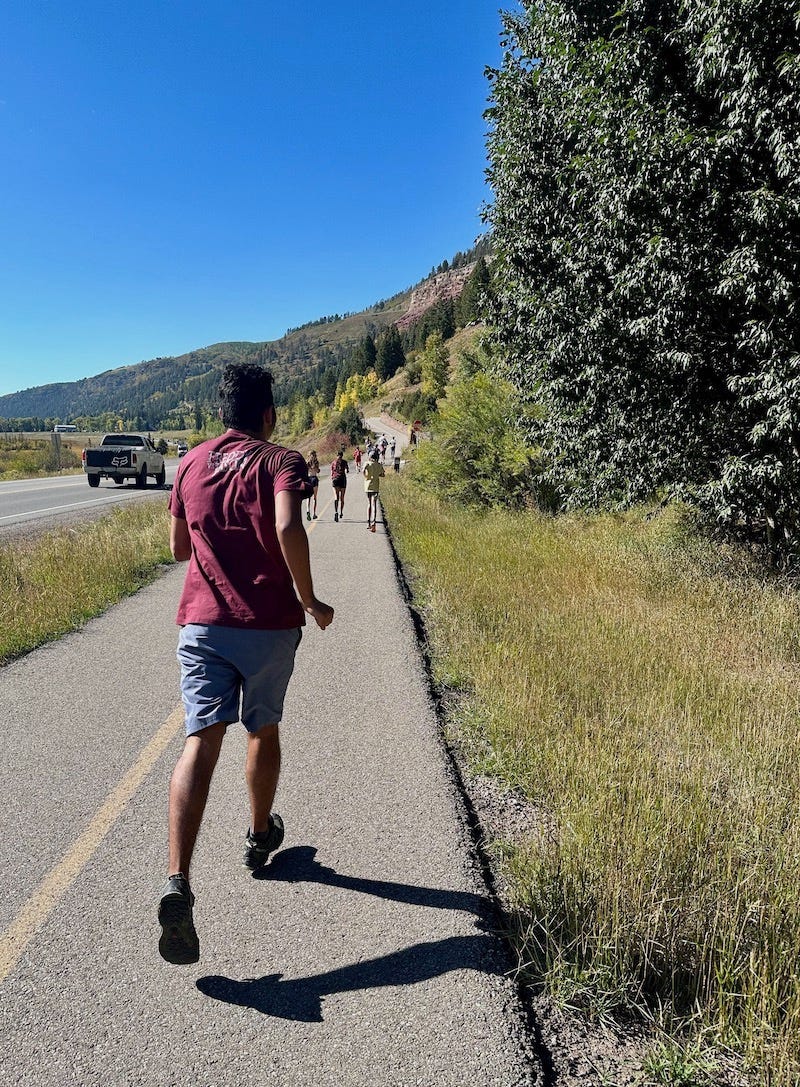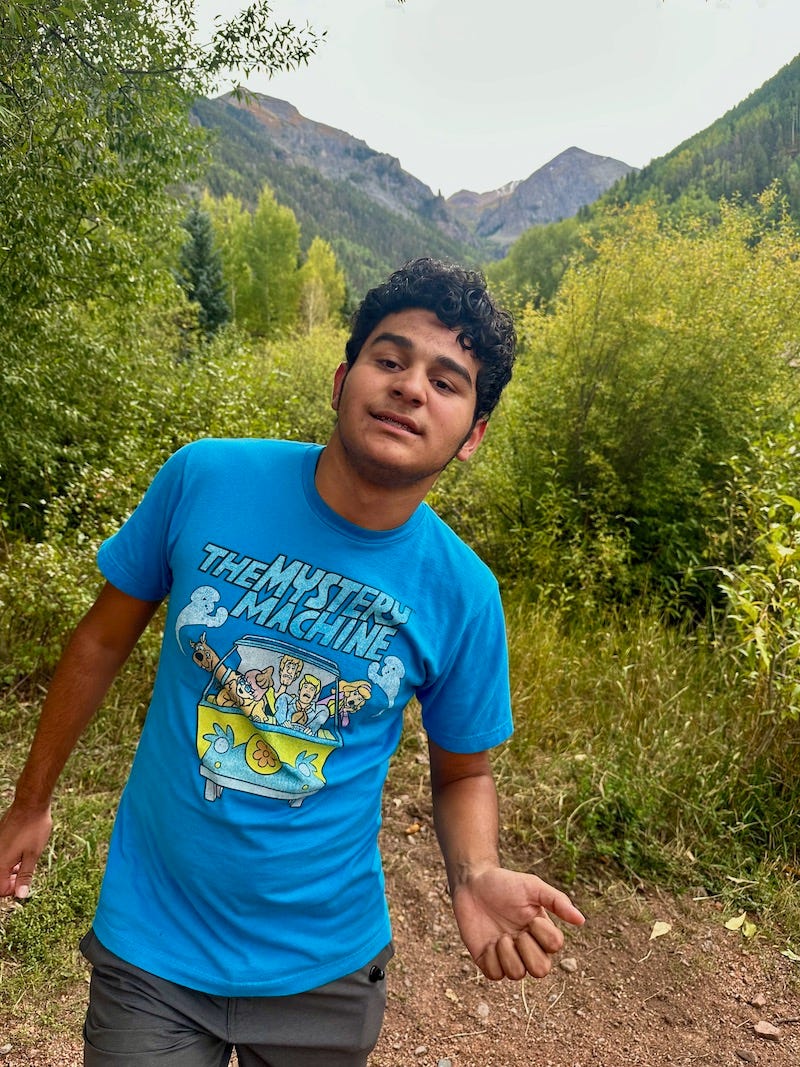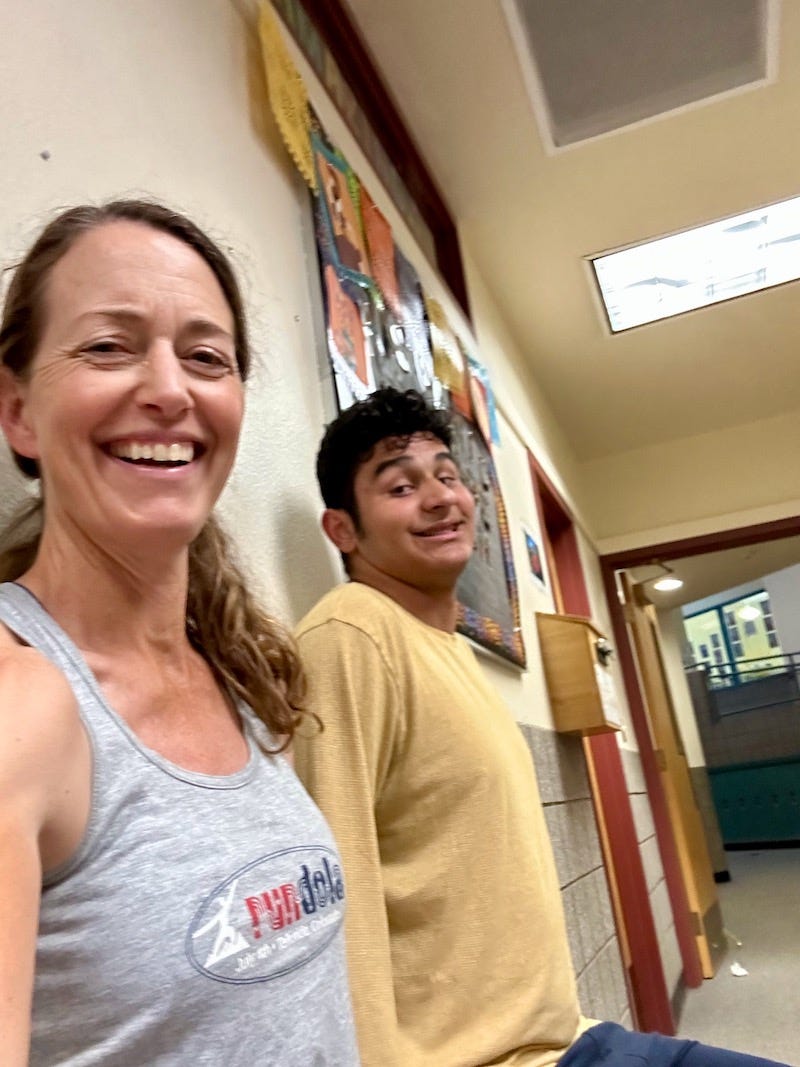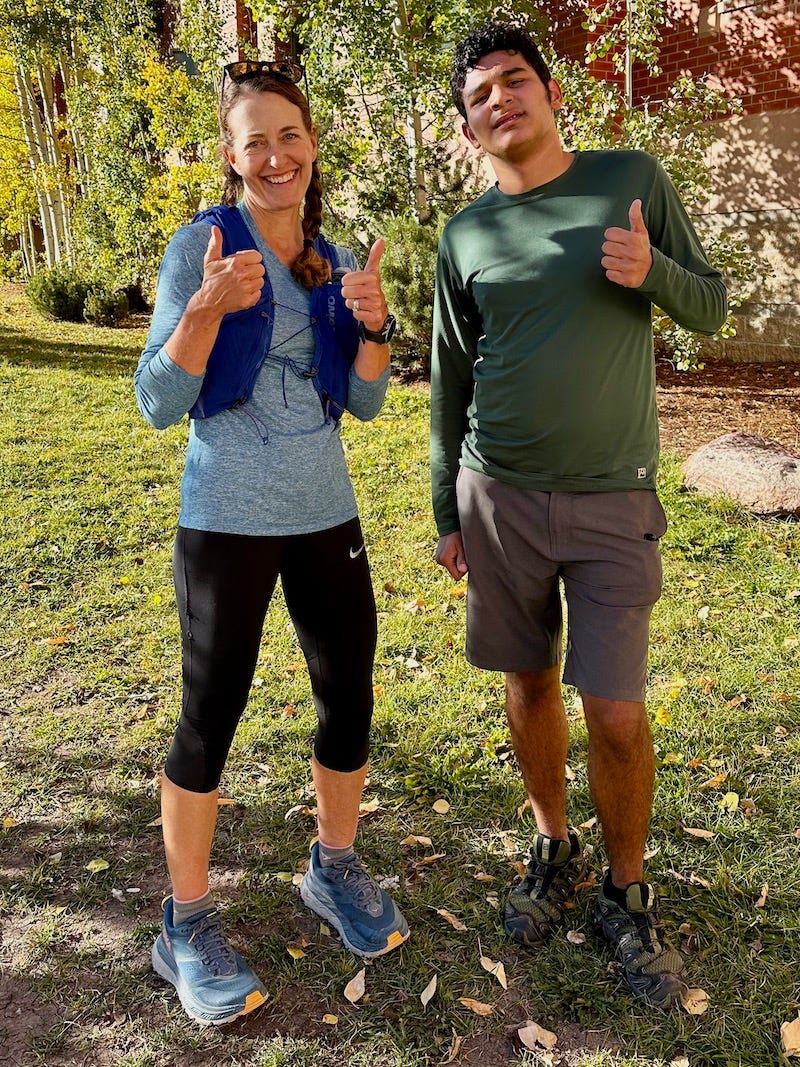Reframing Weaknesses as Strengths
Stories of runners who help me run better (not necessarily faster)
Welcome back! Yesterday, I sent a bonus post to paid subscribers about coping with anxiety, and today we have a monthly online meetup. If you’d like to receive occasional bonus posts and an invitation to join the monthly zoom, please consider upgrading your subscription to paid.
Over the years, I’ve learned so much from running with other runners and observing them.
Sometimes, I learn how not to run and behave. Through racing and pacing others in ultras, I’ve witnessed runners who are overly dramatic, negative, self-absorbed, or excessively picky about gear, food, and drink (all things I’ve been guilty of on occasion). They struggle to adapt to the circumstances, and they wallow in self-pity, focused on things going wrong instead of right.
Often, however, I watch and try to emulate the better qualities of other runners. Seeing champ Courtney Dauwalter’s behavior at aid stations, for example, as she chats with others, cracks jokes, and thanks the volunteers, reminds me to be calm, humorous, and gracious while racing, because acting that way leads to a less stressed, more flowing running form and a positive mindset mid-race.
One runner who influenced me and taught me a lasting lesson is someone who runs with what most of us would consider a handicap or a deficit. This man, Will, is visually impaired, and he hired me as a coach many years ago. He’s legally blind, with only some peripheral vision, due to a genetic condition that caused a type of macular degeneration starting in adolescence. Yet he’s able to run trails and hiked the whole Pacific Crest Trail solo.
As I coached him to train for the Tahoe Rim Trail 100 race (which he successfully finished), I learned about how he uses an app that dictates the trail’s directions and how he sometimes runs with a guide who gives him verbal cues. Mostly, however, he succeeds because all of his senses are highly attuned to his surroundings, and he remains focused on the present moment. He’s also quite fearless, not overly concerned about tripping and falling. If he falls, he falls, and he recovers and keeps going.
From him, I learned to be a more mindful, gutsy runner and to open all my senses, especially hearing and smell, to the surroundings. When I find myself in a mental downward spiral in the middle of a long run or race, I use the trick of pretending that I’m guiding a visually impaired runner like him. I start a narrative in my head that goes like, “log on the left, big rocks coming up so lift your feet, turn right here,” etc., as I describe in detail everything around me. This trick is almost guaranteed to snap me out of negative rumination and force me to focus on the moment, step by step, which in turn helps me run better and feel better.
I also learned from him that perceived challenges and impediments to running, and to life in general, can be reframed as positive attributes.
This week, I have a story about an unusual young runner who generally would be perceived as having a disability that puts him at a disadvantage. Spending time coaching him made reframe his deficits as advantages, and he made me think about some behavioral traits to be a better runner and better person in general.
He also made me consider, how can we reframe our weaknesses as strengths? Instead of thinking of older runners as slower, for example, we could view them as experienced. Instead of viewing mid- or back-of-the-pack runners as less competitive and less specialized, we might celebrate their versatility, endurance, and longevity.
Toward the end of summer, Telluride High School’s HR person, who knows I’m a runner, encouraged me to apply for a paraprofessional job assisting the cross-country team. A “para” is a teacher’s aide who works one on one with special-needs students and helps with classroom management. As a substitute teacher, I sometimes sign up for para jobs.
As a para for the XC team, I’d supervise and support one student, a 16-year-old sophomore boy, who’s autistic. Being on the autism spectrum can mean different things in terms of learning differences, social skills, and behavior, so I didn’t know what to expect or what this student would be like. All I knew is his name is Risho. The HR person assured me that Risho is sweet and cooperative, so I took the job, which entailed meeting up with him and the team two afternoons a week.
(I got approval from his mom to share this story and photos; she’s proud of Risho and wants to spread awareness about autism.)
I met Risho in front of Telluride High the first afternoon of practice in late August. Taller and larger than I, with dark curly hair and brown eyes, he’s originally from Mexico and bilingual.
“Hola, Risho, I’m Sarah, and I’m going to run with you on the team.” I held up my fist, and he fist-bumped it.
“I need my snack,” he said, and reached into his backpack for Fig Newtons. I discovered he is methodical, and a snack right before practice was part of his routine.
As he ate, he paced back and forth in front of the school entranceway, humming to himself and making other small noises while repeatedly bending at the waist and rhythmically moving his arms. I later learned this is called “stimming,” short for self-stimulation, which is common among autistic kids and teens. Many other students exiting the school moved past him, and I was relieved to see that no one acted as if his behavior was strange. A few said hi to him. Telluride High students, for the most part, strike me as kind and accepting, and they’re used to students with learning differences in their classrooms.
The coach had told me that Risho and his mom decided he wouldn’t race with the team at meets, because they didn’t want the pressure of racing, and he tends to need walking breaks. Therefore, he didn’t have to follow the team’s workout, unless he wanted to; he simply would run as much as he felt like—generally, up to two miles total—and it was my job to encourage and supervise him.
We joined the rest of the students for their dynamic stretching warmup, which included drills like high-knees and butt-kickers, and I paired up with Risho to do the exercises. He didn’t seem to mind me being at his side, and when I gave him instructions on how to do the movements properly, he listened and corrected his form.
When it came time to run around town, the rest of the boys and girls took off ahead, and Risho and I began a slow jog to the river path. I quickly realized he’s slower because his stride is extra short, with inefficient lateral movement, and his arm swing also went more side to side than front to back. His arms sometimes moved out of synch with his footsteps.
We paused on the river path so I could demonstrate a more efficient way to run. “Try to move your arms like this,” I showed him, “and when you run, take bigger steps, so your front foot goes in front of you more, like this.”
He improved immediately, and we began running at what I thought was a comfortable pace, with me repeatedly telling him, “Great job!” But he was breathing heavily and started walking after about a quarter mile.
“Water, please,” he said, and I pulled his water bottle out of my hydration pack. He always said “please” and “thank you,” and when we passed walkers on the path, he’d say, “Excuse me, sir” and “thank you, sir!” I thought to myself, if only all teenagers could be at least half this polite and kind.
When Risho and I started running together early in the season, his pace averaged around 12 minutes per mile due to the frequency of his walking breaks. I began challenging him to go farther before taking a break. The first time he ran the whole mile to Town Park without stopping, in about 10 minutes and 20 seconds, we celebrated with fist-bumps, and I took his picture to remember the moment.
“I never ran that far before,” he said repeatedly.
Often, while running, he’d stop abruptly because something caught his eye. We were near a pond by the park when he surprised me by yelling, “Ducks!” We stopped to observe and talk about the ducks. We also always talked about the dogs we passed and counted them.
I tried to ask Risho about his school day, but he preferred to talk about the things around us—he often asked questions triggered by his curiosity of what we observed—and I realized he’s focused on the present and that I should let his questions guide our conversation.
At first, I had a hard time understanding when he spoke quickly or excitedly, because he tends to compress words together. His speech also sounds as if he has nasal congestion, and he elongates vowels, so his what? sounds like waaad? But over time, my ear became accustomed to his way of talking, and we had fun conversations about things around town. We also ran with long periods of quiet when he’d get into a zone of focused running.
After a few weeks, I started challenging him to run at different speeds. I taught him how to do timed strides along the path or across the lawn at Town Park—30 seconds accelerating, 30 seconds recovering—and the bursts of speed improved his running form.
I also challenged him to meet up with the rest of the team when they were doing hill repeats and try one. We showed up after the others had already started, and we joined them at the starting point. When the coach blew her whistle, we charged up the slope. The others ran faster, but Risho made it up the hill, and the coach and I congratulated him.
I was impressed by Risho’s utter lack of self-consciousness—he didn’t seem to care how he compared to the other students, didn’t care what they thought of him, and didn’t have anything to prove; he just seemed happy and willing to participate. He also was content to do his own thing.
I asked, “Do you want to do one more hill repeat?”
“No, I’m good,” he said, and we went off to finish the run separate from the team, at his pace.
Each week, I looked forward to our afternoon runs, because I realized they fulfilled me in a different way than my regular training runs do. Running with Risho wasn’t a “workout” for the sake of exercise per se; it was more like a meetup with a friend. It was a chance to get outside, connect with others, and move in a way that felt good, not stressful.
He reminded me how to run more by feel than time or distance, and how to be unhurried and noncompetitive. His way of running seemed to imply, “Why rush? Take all the time you need.” It was such a refreshing way to run. He also reminded me to look around—to stop and closely observe interesting things and, in the process, to appreciate the surroundings. He put me back in tune with an exploratory beginner’s mindset.
As a coach, I realized that we don’t always have to coach to optimize performance; sometimes, it’s best to coach mainly to achieve fun and to feel good, as I did for several years while working as a run mentor with students participating in Running for a Better Oakland. New skills are learned and health benefits are gained in the process. The whole act of running becomes more process-oriented than outcome-oriented, more of an enjoyable recreational activity than a sport.
When I talked to a couple of other kids on the team who confessed they didn’t like cross-country and they were there because they “had to” or it was their parents’ idea, I wondered if they’d feel differently if they were coached to run for fun and by feel rather than to race for time. For some, running without racing probably feels pointless and unmotivating, but for others, running noncompetitively for the sensation and benefits of the movement might help them enjoy it. It’s a more childlike way of running. Think of how much kids naturally love to run on a playground, and then once it becomes a mandatory timed exercise during PE, it turns into a chore and competition.
Over the weeks, Risho and I worked up to 2.5 miles with fewer and fewer walking breaks. The season ended with a 3-mile team fun run, when the whole team would race a route and aim for their best time, competing more with the clock than with each other.
I wondered if I should encourage Risho to stretch himself to do this event. What if it backfired and stressed him out or sparked a feeling of failure? It felt like a gamble, but ultimately, I encouraged him because I wanted him to gain the confidence and sense of accomplishment of increasing his distance. Also, I hoped he would feel proud to be part of the team.
“You definitely can run three miles,” I reassured him after our last regular practice.
He asked, “How far did we go today?” and I told him 2.1.
“That’s close,” he said, with his natural positivity, and I said yes, it’s close enough to be able to do three.
Last Friday, when the team gathered for the celebratory final 3-miler, Risho seemed to have a touch of nervousness that I never had sensed in him before. I concluded it probably was due to all the parents who were there to watch, including his parents, and that being nervous isn’t necessarily a bad thing. Being nervous means you care.
The coach and I had agreed to give Risho a head start, because we didn’t want him to finish far behind all the teammates, given that he had never run this distance and might end up walking a lot. So, ten minutes before the start, she told all the teammates to gather and send off Risho with a cheer.
Risho and I lined up in the parking lot, counted down, and all his teammates began cheering for him. Tears sprang to my eyes and my throat tightened with emotion because I felt so proud of him.
Risho started much faster than usual, and his breathing sounded labored during the first half mile on the paved bike path. I didn’t want to dampen his enthusiasm and effort for this special run, but I also didn’t want him to “blow up” with overexertion.
“Hey Risho,” I said, “we don’t need to go so fast. Try to run in a way that feels comfortable. Do you want me to go first and set the pace?”
“Yes, please.”
I ran in front of him, at a slightly slower pace, until his breathing sounded better, and then I told him to take the lead and “run in a way that makes you feel like you can keep running.”
Risho ran steadily until close to the halfway point, when he stopped suddenly and said, “Water, please.” I shared one of my water bottles and we walked just a little a bit, and then he started running again. I didn’t talk, except occasionally to say “good job” and “keep going,” because I could tell he was concentrating.
I kept expecting the fastest students on the team to catch up with us, but Risho was running so well that none of them did. We reached the final quarter-mile of the route, and I told him, “OK, this is where you can start to run fast if you want. Try to finish strong. Your mom is waiting for you at the school.”
Risho sped up to about a 9-minute pace, his arms pumping and legs striding fluidly. Again, I felt tears in my eyes, I was so proud of his effort and improvement. I kept encouraging, “Almost there, run fast!”
Because of the head start, he was the first student to approach the finish line, and all the parents cheered for him. He sprinted the way he had learned to do during our strides, and I heard his mom shouting his name.
He finished the three miles in 31 minutes and 20 seconds, high-fiving his mom, his chest heaving from the effort. He looked happy, but exhausted. “I never ran that far before,” he said.
I’m glad he proved to himself that he can run that far, and that he experienced the strong feelings of high effort and an audience cheering for him. But I also realized, he doesn’t need to race to be a runner. Being a runner is about so much more than measuring time and distance.
Finally, I’m proud that Trail Runner today published a story I wrote about a runner and her husband who both have taught me a great deal about character and fortitude. It’s a story about resilience and love. I hope you’ll read it here.
If you would like to support my writing in a way other than a paid subscription, then please consider a donation to my virtual tip jar.








That was amazing. Great job Risho. Thanks for the reminders on enjoying the present moment. Thank you to the blind runner for the reminder to open my senses and not be afraid of falling. Thank you Sarah for sharing your adventures and for continuing to inspire.
What a story. Thank you. Always stop to watch the ducks!